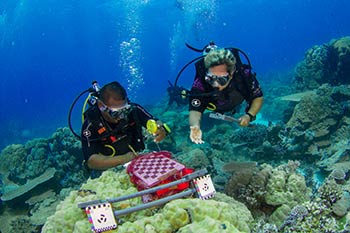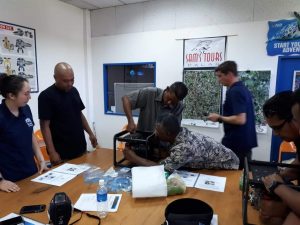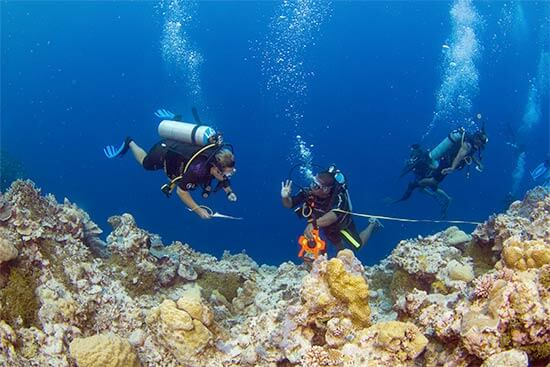OneReef puts hi-tech in local hands to improve reef health

We have lost 50% of intact coral reefs to over-fishing, pollution and climate change. To save what’s left, we start by removing stressors we can control – overfishing and pollution – at reefs that we think can adapt to climate change. The key is to then monitor change over time and make adjustments to maximize adaptation by healthy reefs. Where previously, reef monitoring was done by comparing percent coral coverage, new 3D photomosaics technology renders granular details about which species of coral are adapting and overall reef health. (Watch video of the 2D imaging in process and the 3D mosaic of the reef created from it).
3D images reveal critical aspects of reef adaptation and climate change resilience

To understand if protection of the best reefs is working, it’s critical to measure resilience to climate-induced stress. Cutting edge 3D photo-mosaic technology developed by Scripps Oceanography, machine learning-enabled, can do just that.
3D images allow us to quantify not only coral cover by species, but also how many nooks and crannies are available to provide homes for myriad species on a reef – fish of course, and also invertebrates like clams, shrimp, octopus, lobsters, nudibranchs, snails, and others.
In March/April 2019, OneReef and our science partner, Scripps Oceanography, trained three OneReef Community Partner Teams to use this novel reef-monitoring technology. The teams, two from Palau and one from Pohnpei (Federated States of Micronesia), were also trained in collecting fish data. Combining coral and fish data allows quantification of key species assemblages and diversity on a coral reef.
Seeing-is-believing approach improves management, secures greater local buy-in
Now, OneReef Partner Community members who do the day-to-day reef management wield a powerful monitoring tool, which lets them use rich imagery to communicate reef health and adaptation to leaders and peers. Local communities gain a powerful understanding of their critical role in maintaining intact reefs when frequent and timely information comes from their peers, with photos as proof. Importantly, this aligns with OneReef’s mission of arming communities with the resources they need to protect their reefs. Community members can draw their own conclusions based on the images, instead of being told what to think. There are also opportunities for outreach for policy makers as well as education programs for kids. Watch this video to hear one of the community members speak about the benefits of being trained in 3D mosaic technology.
Making reef conservation more effective
As protected reefs adapt (or not), this tool can also inform relatively expensive investments in repopulating reefs with “super” corals that show adaptive capacity. Scripps scientists are excited because it makes their job of monitoring reef health less labor intensive – and less expensive – allowing them, and us, to monitor more reef areas. With Pacific Island teams now wielding cutting edge coral reef monitoring technology previously only used by scientists, we are at a new frontier of coral reef conservation!